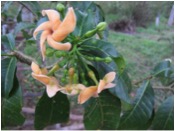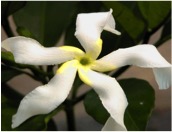Sananga Eye Drops
Sananga is made from the roots and bark of the Tabernaemontana undulata shrub a "milkwood" species in the family Apocynaceae. This sacred and potent medicine is used for healing physical and spiritual ailments, by clearing the mind of distractive energies and allowing for a complete new way of perceiving and focusing. Although Sananga is said to contain Ibogaine alkaloids there is actually little evidence to suggest this is in fact true. Tabernaemontanta is not actually a genus but a "sub-family", and therefore also classified as "Tabernaemontanoidae". McKenna reports that only some of the several dozen or so plants in this sub family contain ibogaine, others like ‘undulata' may only have analgesic or sedative properties.
Usage and Medicinal Effects
The pure spirit of Sananga supports a deep cleansing of blocked energies on emotional, physical, and spiritual levels. Sananga can balance and increase your energies, and find the roots of your diseases and blockages, leading to a complete equilibrium, focus and peace of mind. Moreover, the drops will expand your spiritual vision and awareness, and enhance your ability to read others people´s intentions. Also, Sananga increases your long-range vision, which is important for visualizations and predictions of the future. Apart of this, the drops are also used to cure and improve a broad range of ocular problems (Lambert et al 2010), like myopia, depth and color perception, definition of images, and detection accuracy. Furthermore, this magical medicine is indicated in cases of severe eye diseases, such as glaucoma, cataract, and blindness. As these drops can exert such powerful effects on your visualization, they are also commonly applied before or during Ayahuasca ceremonies, to increase visualization and spiritual insights.
Even though Sananga is famous for its effects on vision and visualization, this medicine is considered to be an indigenous all-purpose remedy. It is applied for febrifuge, emetic, diuretic, calmative, and several other diseases. Furthermore, Sananga is often used to cure skin illnesses (dermatitis), suppress appetite (Jernigan 2009), ease dental problems (Shepard 1999), and counteract snakebite wounds and poisoning, cure eye wounds and rheumatism (Sanz-Biset et al. 2009; Schultes 1979). Another important curative aspect of the Apocynaceae family is its widely explored antimicrobial activity, which showed that this family has strong antioxidant (Pereira et al. 2005), anticancer (Kingston et al. 1977; Gunasekera et al. 1980), antifertility/ contraceptive (Meyeret al. 1973), antipyretic (fever reducing), anti-inflammatory (Taesotikul et al. 2003), anti-mycobacterial (Pereira et al. 2005), and antimicrobial (Beek et al. 1984; Suffredini et al. 2002; Ruttoh et al. 2009) effects.
Traditionally, tribes like the Matsés use Sananga as a hunting tool to obtain a sharp perception and concentration, and to enable the detection of subtle movements in the dark jungle (Lambert et al 2010). Moreover, the drops can enable strong visualizations of the prey or the plant to be hunted, allowing for a quick and successful quest. Often Sananga is combined with other hunting tools, like Kambo, which further enhance the hunting skills. For most indigenous tribes, hunting means survival and therefore signifies an exceptionally important and crucial ability.
 Image: Tabernaemontana undulate
Image: Tabernaemontana undulate
Copyright: www.spiritplants.org
The tribes believe that becoming a good hunter and a good aimer, can only be achieved by using sacred plants. These sacred plants enhance the perception and sharpness, intention, sense of smell, endurance and luck. Therefore, hunting tools like Sananga and Kambo, account for about a quarter of all medicinal plants used in indigenous tribes (Shepard 1999).
Origin, Creation and Application
Sananga eye drops are made from the Tabernaemontana undulata shrub that grows in Acre, Brazil and other South American countries, and is known to the Kaxinawás tribe as “Mana Heins” and as “Becchete” to the Matsés. Mana Heins or Becchete belong to the Apocynaceae family, the same family that iboga (Tabernanthe iboga) belongs to (König et al. 2015). The bark of the root of this shrub is first ground to a very fine powder that is strained various times through a cotton mesh and finally it is extracted into a juice. When applied on the skin, Sananga leaves are softened by fire, and applied directly on the affected part, or the latex from the root is mixed with water and applied with a cloth (Van Beek et al. 1984). Yet, it can also be applied with a drink made with a water extract of the root bark.
 Image: Tabernaemontana sananho
Image: Tabernaemontana sananho
Copyrights: www.toptropicals.com
Active ingredients and effects
Sananga is said to contain an abundancy of alkaloids (Liu et al. 2013), It has been hinted that Sanaga includes the potent active ingredient is ibogaine (König et al. 2015), However this statement has yet to be sceintifically proven. Apart from ibogaine, several other alkaloids, such as coronaridine, quebrachidine, heyneanine, 3-hydroxycoronaridine, ibogamine and voacangine (Van Beek et al 1984; delle Monache et al. 1977) have been thought to also be contained in Sananga. All of these alkaloids have powerful psychoactive effects and can exert strong antibiotic effects.
There can be slight differences in the composition of Sananga: the Becchete from the Matsés tribe contains Tabernaemontana undulata roots, whereas the Sananga eye drops from the Kaxinawá tribe contains Kunakip (Tabernaemontana sananho) roots. Both of these roots are known to produce strong vision (waimatai) that are very useful for successful hunting (Jernigan 2009).
Dose
Before thinking about the dose, you should read carefully our thoughts on the power of your intention: every medicine can only achieve and cure what you are intending.
Only one drop per eye is enough for a powerful Sananga session. We recommend to find a calm and quiet place, either in nature, or at home in a peaceful setting and with meditative music. The acute effects will wear off after 10-15 min, yet subtle after effects can last for days. Make sure you lie down to enable a good application and leave your eyes closed during the session. It is important to apply one drop to both eyes, and do not wait with the second drop, apply it immediately to balance out the energies on both eyes. Thereafter, you should blink with your eyelids for a short while to distribute the liquid over the whole eye. Ideally, you find a second person who can apply the Sananga for you.
Shortly after the application to the eyes, most users report a strong burning and intense prickly pain sensation. Yet, these effects reside after a few minutes, and can be alleviated by focusing on your breathing and by visualizing how the pain removes your blocked energies and brings deep healing. Moreover, you may also experience vomiting and bowel movements, which are further indications for the removal of blocked energies and illness. Try to surrender fully and relax as much as possible.
Similar to the iboga micro dosing, you can apply Sananga on a daily base but you should adhere to our protocol and stick to strong intentions of healing to achieve profound results.
Insights
A customer reported to me that he tried Sananga eye drops. And his comment was: "...It didn't work. All I had was extreme pain and nothing else, so it didn't work...". So I explained him the effects of Sananga and the benefits of the pain:
"It seemed to have worked perfectly. The pain of the Sananga allows the healing. If it doesn't hurt, you won't achieve that process. The pain allows you to ground and balance. The first times it may cause suffering and drama but when you understand what to do with it you can achieve a state of zen and fearlessness. And it will be easy. Take the pain without drama. And at some point you will be able to take Sananga the moment you think about it. Without any hesitation or doubt or fear for whats coming. And then you drop it in the eyes, and you just allow what happens. Go in the process without any expression. Be calm, breathe, take the pain but don't let it cause despair. Sit up straight, roll your eyeballs and don't show anything of your inner struggle. You can channel all that pain into power, immediately. And the benefits afterwards are not only fearlessness. It rids you of drama, irritation, pain, fear, anger. And it has beneficial effects on your eyes, it takes the accumulated dirt away from your lens, and also from the back of your eyes. You will have better focus, both visually and mentally. You will "see" things better. Sananga can make you a warrior, and 15 minutes after the experience, up to days after, and in some cases permanently, you have determination to achieve anything, and you will not be hindered by negative emotions any more. If you can deal with Sananga you can deal with every day life much better, especially in situations where you are challenged to fall into negative emotions, drama, fear or anger."
Cautions
Contact lenses should be removed before applying Sananga.
Storage
Please keep the bottle refrigerated, the ingredients are very fragile and can easily decompose and catch molds or fungi.
Copyright
All contents of this website are protected under copyright law. Redistribution, retransmission, republication, or commercial use of the contents or images on this website are expressly prohibited without the consent of Katukina. All rights reserved.
Links:
References
Beek VTA, Verpoorte R, Svendsen AB, Leeuwenberg AJ, Bisset NG (1984). Tabernaemontana L. (Apocynaceae): A review of its taxonomy, phytochemistry, ethnobotany and pharmacology. J Ethnopharmacol.;10(1):1-156.
Beek TAV, Kuijlaars FLC, Thomassen PM, Verpoorter R, Svendsen B (1984). Antimicrobially active alkaloids from Tabernaemontana pachysiphon. Phytochemistry, 23(8):1771–1778. Delle Monache G, de Matta SM, delle Monache F, Marini-Bettolo GB (1977) Atti Accademia Nazionale dei Lincei, Memorie, Classe di Science Fisiche, Matematiche et Natumli [viii] 62, 221.
Gunasekera SP, Cordell GA, Farnsworth N (1980). Anticancer INDOLE Alkaloids of Ervatamia heyneana. Phytochemistry, 19:1213–1218. 17.
Jernigan KA (2009). Barking up the same tree: a comparison of ethnomedicine and canine ethnoveterinary medicine among the Aguaruna. J Ethnobiol Ethnomed.; 5: 33.
Kingston DGI, Bernard TLI, Ioescu F (1977). Plant anticancer agents 111: isolation of indole and bisindole alkaloids from Tabernaemontana holstii roots. J Pharm Sci, 66(8):1135–1138. 16.
Koenig X, Hilber K (2015).The anti-addiction drug ibogaine and the heart: a delicate relation. Molecules.;20(2):2208-28.
Liu L, Cao JX, Yao YC, Xu SP (2013). Progress of pharmacological studies on alkaloids from Apocynaceae. J Asian Nat Prod Res.; 15(2):166-84.
Meyer WE, Coppola JA, Goldman L (1973). Alkaloid studies VIII. Isolation and characterization of alkaloids of Tabernaemontana heyneana and antifertility properties of coronaridine. J Pharm Sci, 62(7):1199–1201.
Pereira CG, Leal PF, Sato DN, Meireles MA (2005). Antioxidant and antimycobacterial activities of Tabernaemontana catharinensis extracts obtained by supercritical CO2 + cosolvent. J Med Food, 8(4):533–538.
Ruttoh EK, Bii C, Tarus PK, Machocho A, Karimi LK, Okemo P (2009). Antifungal activity of Tabernaemontana stapfiana Britten (Apocynaceae) organic extracts. Pharmacognosy Res, 1(6):387–391.
Sanz-Biset J, Campos-de-la-Cruz J, Epiquién-Rivera MA, Cañigueral S (2009). A first survey on the medicinal plants of the Chazuta valley (Peruvian Amazon). J Ethnopharmacol.;122(2):333-62.
Shepard G: Pharmacognosy and the Senses in Two Amazonian Societies. In PhD Dissertation University of California, Berkeley, Medical Anthropology Program; 1999.
Schultes RE (1979) Journal of Ethnopharmacology 1, 165.
Suffredini IB, Bacchi EM, Sakuda TK, Ohara MT, Younes RN, Varella AD (2002). Antibacterial activity of Apocynaceae extracts and MIC of Tabernaemontana angulata stem organic extract. Braz J Pharm Sci, 38(1):89–94. 23.
Taesotikul T, Panthong A, Kanjanapothi D, Verpoorte R, Scheffer JJC (2003). Anti-inflammatory, antipyretic and antinociceptive activities of Tabernaemontana pandacaqui Poir. J Ethnopharmacol, 84:31–35